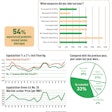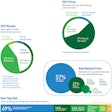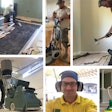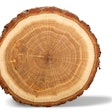

State of the Industry 2005
Not so many decades ago, wood flooring manufacturing involved a few tight-knit groups of men located in the Deep South and the North Woods. Everyone knew almost everyone, business was done on a handshake, and product selection was mainly oak or… oak.
Fast-forward to 2005, and in many ways, the industry is hardly recognizable. The heart of manufacturing in the South and the North Woods still exists, but products also are produced around the world, particularly in Asia. Species are sourced from every corner of the globe. Factory-finished products of every variety continue to gain in popularity.
Almost suddenly, today's suppliers are style-savvy, with close ties to the design community. Consumers, feasting on a steady diet of media from HGTV to "This Old House," are increasingly educated about style and design. Manufacturers try to stay two steps ahead by predicting what the homeowner will ask for next year and the following year.
Mapping Trends
While the industry in 2005 is more cutting-edge than ever, many of today's wood flooring styles are turning back the clock. New product introductions at the Surfaces 2005 trade show in Las Vegas revealed that dark colors, wide planks, ultra-low-sheen finishes and an array of surface textures are increasingly prevalent.
"Everything in our line and hardwood in general has really been driven by rustic growth, and that really means texture, whether visual texture or physical texture," says John Himes, director of hardwood business for High Point, N.C.-based Mannington Mills.
While many in the industry had thought that distressed flooring would be a short-term fad, it has proven to have staying power. Today's floors vary widely from the hand-scraped look that was first introduced by most companies. Distressed flooring of every sort imaginable is being produced, from heavily hand-scraped floors with dings and dents to floors that simply look timeworn.
With all the new product introductions involving textured flooring, manufacturers are confident that, far from being a fad, the style is still gaining momentum. "If you stand back and think about how many consumers in the U.S. are even aware of the hand-scraped floors at this point in time, it's minimal," says Analie Roth, vice president, marketing, for Johnson City, Tenn.-based Tarkett Wood. "… So, we're a long way from peaking out in this particular trend."
At the Domotex trade show in Hannover, Germany, Anderson Hardwood Floors' CEO Don Finkell found that the trend has even penetrated the European market, where modern, clean lines typically dominate interior design. "I had German women coming through our booth looking at hand-scraped floors, and they really seemed to like it. Two years ago, I would have said that would never happen."
Along with the textured flooring are widths—all sizes of plank—and finishes that are appropriate to the style. Because most of the floors look aged to some degree, they usually have a lowgloss sheen that mimics a real oil or oiland-wax finish that would have been applied on older floors. While in the past factory-finished manufacturers had difficulty producing a modern finish with an ultra-low sheen, new finish technology is now making that possible, Himes explains. "In the last two years, there's been enough technology on the urethane side that you can get urethanes down to a 10 or 12 gloss [on a gloss meter] and still have them look really great," he explains.
The margins on such products are a boon for manufacturers. "It's really kind of unbelievable how prefinished handdistressed turns consumers on to the point that they're willing to pay a lot more for that look—for an upgrade—like I've never seen before," says Neil Poland, president of Johnson City, Tenn.-based Mullican Flooring. He adds that the biggest change he has seen recently in consumer preferences is the choice of plank instead of strip flooring, regardless of whether it is distressed or not.
Around the World
Along with the trends for plank flooring, textured surfaces and dark colors, exotic species continue to gain momentum. As they become more commonplace, however, manufacturers are finding that sourcing these species is becoming more of a challenge. While demand has increased, countries such as Brazil are implementing tighter controls on logging.
"A lot of those exotic species—santos mahogany and Brazilian cherry are two big ones, but there are others—are becoming increasingly expensive and hard to find in any kind of quality and quantity you'd want," says Patrick Barnds, vice president of hardwood flooring products at Lancaster, Pa.-based flooring giant Armstrong.
The rainy season in different parts of the world also can wreak havoc with supply, making relationships with quality suppliers who have access to large quantities more important than ever. "You could be dealing with small companies that might give you a great price today, but might not have any four months from now," explains Paul Stringer, director of marketing at Somerset, Ky.-based Somerset Hardwood Flooring Inc.
The challenges with sourcing foreign materials along with the increased demand for them has resulted in companies going to greater lengths to find quality products from reputable suppliers.
More than ever, manufacturers need to be sure their materials are coming from legitimate sources, not clandestine operations cutting protected areas. "We've gone from a three-person sourcing team to a 15-person sourcing team over the past 18 months," Barnds says. "You have to have people on the ground at the manufacturing location and people following that chain of custody." The detriment to high-profile companies could be enormous if they were found to be using exploited resources, he adds. "The Armstrongs, Shaws, Mohawks and Manningtons of the world really need to be cognizant of these things, and we are."
Barnds predicts an even greater increase in the number of species used for wood flooring, not because of consumers' desires, but simply because of supply limitations. "I think you'll see a very dramatic expansion of species, but not for the reasons you think," he says, adding that Armstrong is currently negotiating exclusivity on five or six species previously unheard of in the wood flooring industry.
The high quality of today's staining technology provides other options for flooring manufacturers that don't want to rely on foreign supplies. "You can get the the same type of look that you might achieve with an exotic with a maple or birch product that's stained," says Chris Thompson, vice president of sales & marketing for St. Georges, Quebec-based Mirage/Boa-Franc Inc.
Among the stain colors, as with species, dark is where it's at. "Last year, we couldn't keep stock in the darker stains," says Gary Wu, sales manager at City of Industry, Calif.-based Johnson Premium Hardwood Flooring.
At Surfaces, more vibrant and unusual colors, from blue to nearly black, also were appearing.

Traveling Trends
The color trend follows a typical pattern for the wood flooring industry moving from the West Coast to the East Coast. It has long been common wisdom in the industry that wood flooring style trends follow that path, but it's relatively recently that wood flooring is commonly considered to be connected to style at all.
"I feel that the wood flooring industry has been a little bit behind the times from a décor point of view," says Tarkett's Roth, who has a background in fashion, home textiles and home décor.
That opinion is echoed by Melanie C. Wood, a color and design consultant based in Knoxville, Tenn., who heads Anderson's design council. "I think flooring in the past has been considered something of a utilitarian product—you concentrated on the furnishings and the four walls, not the floor. People are coming to realize that the floor can be a very dramatic part of the finished project," she says.
This awareness is driven in large part by the tremendous popularity of home improvement. Inundating media from magazines to TV shows, home renovation is now considered trendy. Increasingly sophisticated consumers are thinking about design, and today's wood flooring manufacturers are trying to read their minds.
To accomplish that, leading wood flooring manufacturers now attend trade shows related to home décor, meet with designers across the country, run consumer focus groups and participate in organizations such as the Color Marketing Group, which forecasts colors for all products and industries.
"We're looking to trends in other industries to see how we can apply that to wood flooring—we look at apparel, furniture and cabinetry," Anderson's Finkell says. He recalls having a conversation with a designer from a leading clothing manufacturer. "I asked him, 'Where do you guys get your trends.' He said, 'Our belief is that if you go back and see where all trends start, you will eventually trace them to shoes.' It trickles down to us and somehow makes sense," he says.
In the past, many new product introductions were driven by what a handful of wood flooring executives found interesting or functional. By being plugged into the design world, from fashion to cabinets, manufacturers now avoid the common mistake of offering a product they liked but consumers didn't want.
"You can have the most feature-driven floor ever, but if it's a little bit off from what the customers already decorated in their houses, they can't use you," Mannington's Himes says. "Being able to match and coordinate with those other design elements is absolutely critical."
One specific area where color coordination is vital is in the builder market. Although it is a huge segment of the wood flooring industry, it's more often associated with a low price point than with style. But design-savvy wood flooring manufacturers are making sure they are in touch with the needs of the big builders, who now often run large design centers where their clients can choose every element of their home interior.
Price is still key where builders are concerned, but color also is important, manufacturers say. "We are finding that it's paying dividends to have more active involvement with some of these builder design people. We're trying to look ahead at what they plan to do with cabinets next year, because they drive a lot of the flooring decisions," Armstrong's Barnds says.
Even more design-oriented floors such as the textured products are becoming firmly entrenched in some builder markets. "Hand-scraped flooring and the builder community on the West Coast just go hand in hand—those guys can't open a model home without having an enormous hand-scraped selection," Himes says.
Manufacturers must offer the styles and colors the builders' customers want, while still providing the features necessary for the builders themselves. Products that accommodate an uneven subfloor and other problems that can happen on a tight builder schedule often drive the creation of products with practical features such as beveled edges and ends, manufacturers say.
Asian Influence
The lower-end builder market is one area where industry observers have long predicted to see a strong impact from Asian imports, especially from China, but the Chinese impact on all segments of the industry still appears to be limited. Manufacturers cite cutthroat pricing at the lowest price points as the biggest factor of Asian imports.
"Asia has played a major role in today's lower-end pricing levels—both in engineered and solid products—with limited color offerings to manufacturers, distributors and retailers who are prepared to deal with the challenges of these products," says David Wootton, president of Danville, Va.-based Columbia Flooring.
More of these products are on the way. There were unprecedented numbers of Asian exhibitors at Surfaces in January, and many competitors here say those companies are struggling to find a channel to get their product to market. Oftentimes, what they are really seeking is the notice of a domestic manufacturer looking to augment its own flooring supply. "The discussion of Asian products continues to be more discussion than actual sales," Mullican's Poland says. "A lot of those people in the basement at Surfaces still don't have an alliance with a major U.S. manufacturer or distribution in the U.S."
"One of the things I'm concerned about is I think the American companies are helping show the Chinese companies how to go to market, either through buying them and selling private label products or by being agents for the products," says Somerset's Stringer.
Concerns about quality keep many from doing business with the legions of new Asian companies entering the market. Domestic manufacturers cite numerous lawsuits brought by distributors against some Asian suppliers as evidence that the products aren't always what they are promised to be.
In particular, there are concerns about the durability of "Chinese oak," which is usually oak imported to China from Siberia. "There really is no such thing as a free lunch. You bought this stuff for a $1.99 and you expect it to last like a $3.00 floor, and it's doesn't. You've got consumers upset and distributors suing these importers," Armstrong's Barnds says.
Other times, dealing with an unknown supplier leads to supply problems, says Johnson Premium's Wu. "At the show, we got information that lots of factories from China are coming in with lower pricing. People can quote lower pricing, but whether they can back up with the stock is another question," he says. He says his company has an advantage compared with other imported Chinese products because it owns its manufacturing facilities in China, and because it has operated in the United States since 1999.
Whatever quality issues may be present with Asian manufacturing now, most people say they are steadily diminishing as the industry there matures, and they expect the quality to continue improving in the future. Today's wood flooring producers accept Asian competition as a fact of life, as it is in nearly every other industry, and they're pursuing strategies to level the playing field. Creating their own facilities in low-cost labor markets and private-labeling products from abroad are two avenues in which domestic producers can compete, but those avenues must be pursued carefully.
"I can only speak from the experience we've had over the past few years: It takes an awful lot of very diligent effort to get another manufacturer dovetailed in with high-quality production, especially if you have a reputation for that," Himes says.
At Anderson, Finkell says that some of the company's production is partially manufactured in South America. However, "We haven't had the confidence in anybody overseas to allow them to put something in a box and let our customer be the next one who sees it," he says. "But, they're getting better. It's inevitable that they'll have the expertise to do those things, it's just a question of when."
Mullican Flooring is working with an "Asian manufacturing partner" to produce its new engineered line, with most of the raw materials supplied by Mullican or related companies, manufactured in Asia and shipped back to the United States. The reasoning behind the decision to manufacture in Asia was two-fold, Poland says. Of course, the labor cost was advantageous, but experience with the technology for sliced and sawn-face engineered products as opposed to rotary-peeled products was also a top priority. "Because Asian manufacturers have been supplying Europe with sliced and sawnface products for a long time, they are better equipped with the right technology to produce the quality of these products," Poland says.
Working with production abroad isn't the only strategy to compete. Domestic manufacturers are still heavily focused on improving their existing manufacturing facilities. While Wootton says that Columbia has "developed alliances with strategic Asian partners," the company also is in the process of doubling the size of its engineered flooring manufacturing facility in Danville, Va.
Armstrong's Barnds says that less than 7 percent of Armstrong's wood flooring is manufactured overseas, and it has concentrated heavily on manufacturing efficiencies here, which help minimize the Chinese advantage of low labor costs. "In the past few years, we've effectively doubled the productivity of our engineered plant [in the U.S.]," Barnds says. "You can never discount the imports, but we believe we are essentially globally competitive in our engineered flooring today." There are certain types of wood flooring, such as solid exotic species, for which it simply makes sense to have manufacturing facilities in Asia, he says, however, "I think the forecasts of the doom of the U.S. hardwood flooring industry are greatly exaggerated right now."
As the industry matures and becomes increasingly global, it's an obvious advantage to have the savvy of being a global company. "One of the things we have as an advantage is that we are part of global corporation," says Tarkett's Roth. "We have a very significant amount of business in eastern and western Europe, and are moving into other areas as well, so it does allow us to have a pretty good understanding of what's going on out there in the world and to have the steps necessary to remain competitive," she adds.
Whether wood flooring manufacturers compete directly with Asian importers or not, the whole industry is affected to some degree. "The market is only so big, and any time you have an additional capacity coming on-stream in an industry, it's going to impact everybody in it in one way or another," Mirage/Boa-Franc's Thompson says.

Back at Home
One segment of the wood flooring industry that's going through a cycle of difficult times right now—unfinished solid domestic flooring—has little to do with Asia. The bread and butter of the industry, solid unfinished oak strip flooring, is selling at its lowest prices in years, and manufacturers place the blame largely on themselves. A combination of factors, including scarce lumber supplies last year, drove strip flooring prices up to what some say were unreasonable levels.
"We got the prices up too darn high last year," says Butch Ousley, sales manager at Aliceville, Ala.-based Buchanan Hardwood Flooring Co. LLC. "Italian marble could compete with hardwood flooring."
As a result, many manufacturers that produce both unfinished and factoryfinished flooring found that it was more profitable to put their flooring supplies into the unfinished market. Combined with the additional supply produced by unfinished manufacturers who had been adding more lines and more shifts, a veritable flood of unfinished strip flooring hit the market, and predictably, prices crashed.
"Customers are telling me, 'I'd love to take four truckloads, but it might be a nickel cheaper next week, so give me one,'" Stringer says, a sentiment echoed by every strip producer.
This is despite the fact that demand for unfinished strip flooring is at its highest level in years. The production statistics from NOFMA: The Wood Flooring Manufacturers Association show that more strip flooring was shipped in 2004 than had been since 1966 (see chart on page 26), when the FHA approved carpeting as an acceptable floor covering in new homes, and the wood flooring industry took a decades-long nosedive.
"In the last four or five years we've managed to out-produce a very good market," says W.T. Mullican, general manager of operations at McMinnville, Tenn.-based McMinnville Manufacturing Company. "The dynamics of the market are such that it's the best—at least in my lifetime—as far as the quantity of movement in wood flooring and unfinished in particular."
"Here we are with great housing starts and great interest rates [see charts on page 22]; we've just got more of an item than there's demand for," Ousley concurs.
Those in the industry agree that the current prices are unsustainable for any length of time. While they don't see a quick turnaround, they do expect things to improve as supply comes offline. Some manufacturers have shut down lines, cut the number of shifts or otherwise curtailed production. Some observers predict a downsizing in the number of manufacturers.
"Our industry has always been faced with cycles, and we're going through another one; they come and they go," says John Clark, sales manager at Hazelnurst, Miss.-based Cherrybark Flooring and president of NOFMA. "The strong survive, and the weak perish. Your whole goal is to be one of the strong."
"The companies that have efficient production, good quality, good marketing programs and a strong distribution base, they will survive," Stringer says. "The ones who don't have those things are going to start laying people off and having financial problems."
While some companies may be struggling in the current market, the continued demand for all types of wood flooring bodes well for the entire industry, most say. "Right now, the prices in the marketplace are disappointing, but industrywide, I think it's encouraging about how much flooring is being moved, and I think it's a good future for those who are strong financially," Mullican says.
Cherrybark's Clark expects wood flooring's slice of the floor covering market to continue growing in size, but it won't always be easy: "I think it will be an exciting time to be in the business, even though there are challenges that go along with it." That's a sentiment shared by many in the wood flooring industry as they look forward to a bright, but perhaps more complicated, future.
Mapping the Numbers
In January, Hardwood Floors surveyed distributors and contractors to find out how they did in 2004 and which products they were using. Approximately 89 percent of contractors who responded specialized in wood flooring; while 85 percent of distributor respondents were wood flooring specialists. Here's what they told us:
Points of Purchase
Of the contractors surveyed (more than one answer possible) ...
82% buy from specialty wood flooring distributors
33% buy from general floor covering distributors
35% buy from a big-box store
40% buy direct from manufacturers
At a big-box store, contractors say they are most likely to buy (in order of likelihood):
- installation tools
- adhesives
- wood flooring
- finish
- abrasives (tied) sanding equipment (tied)
Contractors' Business in 2005 ...

In 2003...
• 64 percent of contractors indicated that business increased
• 22 percent stayed the same
• 14 percent decreased
Stop and Shop
Of the distributors surveyed ...
42% said their business has been affected by big-box stores such as Home Depot and Lowe's
58% said they have not been affected by big boxes
Looking for Laminate?
Of the distributors surveyed ...
61% sell a laminate (Pergo-type) product
39% do not
Distributors' Business in 2005 ...

In 2003 ...
• 74 percent of distributors indicated that business increased
• 15 percent decreased
• 11 percent stayed the same
Finish Used by Contractors

In 2003, contractors said ...
• 63% oil-modified
• 31% water-based
• 4% conversion varnish
• 1% moisture cure
• <1% wax
Finish Sold by Distributors

In 2003, distributors said ...
• 58% oil-modified
• 34% water-based
• 4% conversion varnish
• 4% moisture cure
• <1% wax
Species Installed by Contractors

The contractor numbers in 2003 were ....
• 59% red oak
• 20% white oak
• 7% maple
• 5% Brazilian cherry
• 4% other domestics (cherry, ash, birch, beech)
• 3% other exotic species
• 2% Heart pine
Species Sold by Distributors

The distributor numbers in 2003 were ....
• 42% red oak
• 19% white oak
• 10% other exotic species
• 9% Brazilian cherry
• 8% maple
• 6% other domestics (ash, birch, beech)
• 5% Heart pine
Contractors Are Installing ...

Contractor numbers in 2003 were ...
• 76% unfinished solid
• 14% prefinished solid
• 10% prefinished engineered
• <1% unfinished engineered
Distributors Are Selling ...

Distributor numbers in 2003 were ...
• 49% unfinished solid
• 35% prefinished solid
• 14% prefinished engineered
• 1% unfinished engineered
How Contractors Spend Their Time
What They Do ...

In 2003, contractors divided their business, on average ...
• 54% sanding/finishing/refinishing
• 46% wood flooring installation
Brand New vs. Renew

In 2003, contractors divided their business, on average ...
• 66% remodeling
• 34% new home construction
Subfloors Are …

In 2003, contractors installed over ...
• 57% basement
• 25% crawl space
• 18% slab
Similar Situation?While many people feel that the threat to domestic wood flooring manufacturing due to China is overblown, many others point to the "collapse of the American furniture industry" as a result of Asian manufacturing as an example of what could happen to the domestic wood flooring industry. Here are a few facts about the American furniture industry's decline: • In 2002, the U.S. trade deficit for residential wood and upholstered furniture and components mushroomed from $2.43 billion to $11.14 billion. • In North Carolina, the core of American furniture manufacturing, jobs in manufacturing wood household furniture decreased by nearly one-third from 1993 to 2003. • Between 1980 and 1990, North Carolina experienced a net gain of 192 furniture companies. Between 1990 and 2000, there was a net loss of 47 companies. • In 2002, more than two-thirds of domestic production was being imported, and today, that number is even greater. • Hourly wages for furniture workers in China are between $0.50 and $0.75 per hour. • It costs as little as $3.00 per square foot to increase factory size in China, while in the United States, expansion costs run about $15.00 per square foot. • The threat of tariffs, imposed on Chinese bedroom furniture in November 2004 and lowered in early 2005, caused some Chinese furniture manufacturers to simply move production to other Asian countries. (Source: The Wall Street Journal Online) • A report from the University of North Carolina's Kenan-Flagler Business School proposed that a reduction in overhead costs and a focus on comparative advantages held by U.S. manufacturers could save the industry. One method to reduce overhead costs was consolidation of the highly fragmented industry. Comparative advantages included quality of design and finishing. Source except where noted: Duke University Markets & Management Capstone Course (https://ncglobaleconomy.com/) |


































